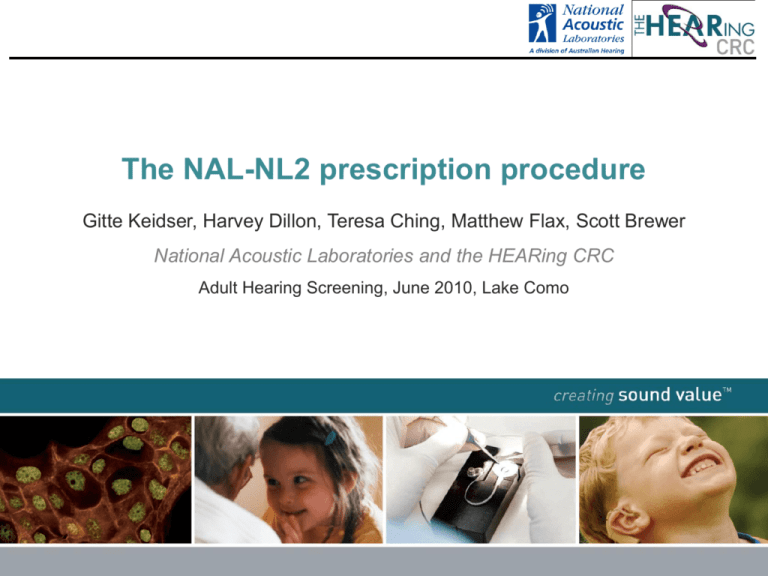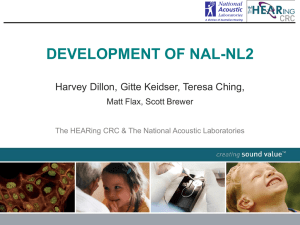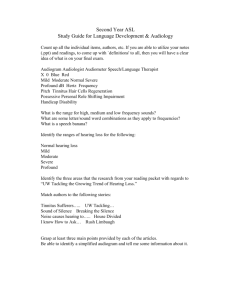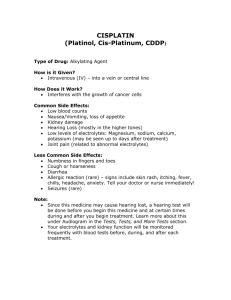NAL-NL2 for Cernobbio
advertisement

The NAL-NL2 prescription procedure Gitte Keidser, Harvey Dillon, Teresa Ching, Matthew Flax, Scott Brewer National Acoustic Laboratories and the HEARing CRC Adult Hearing Screening, June 2010, Lake Como TM TM creatingsound sound value creating value www.hearingcrc.org Overall approach to prescription Psychoacoustics Assumptions, rationale Theoretical predictions Compare Speech science Empirical observations creating sound valueTM Adjust NAL-NL1 NAL-NL2 Rationale • Make speech intelligible • Make loudness comfortable Prescription affected by other things – – – – localization, tonal quality, detection of environmental sounds, naturalness creating sound valueTM Deriving optimal gains Speech spectrum & level Loudness model Gain-frequency response Normal loudness Compare Intelligibility achieved Intelligibility model Amplified speech spectrum Audiogram creating sound valueTM Loudness model Loudness (hearing impaired) Deriving optimal gains Audiogram 1 Speech level 1 Optimal gain frequency response Audiogram 1 Speech level 2 Optimal gain frequency response Audiogram 1 Speech level 3 Optimal gain frequency response Audiogram 2 Speech level 1 Optimal gain frequency response 200 audiograms x 6 speech levels 1200 gain–frequency responses, each at 20 frequencies from 125 Hz to 10 kHz 24,000 data points creating sound valueTM Multi-dimensional equation A neural network H250 H500 H1000 H2000 H8k G250 G500 G1000 G2000 G8k creating sound valueTM SPL Deriving optimal gains New Speech spectrum & level Loudness model Gain-frequency response Normal loudness Compare Intelligibility achieved Intelligibility model Amplified speech spectrum Audiogram creating sound valueTM Loudness model Loudness (hearing impaired) 1: Change to SII model SII SIIansi = Ai.Ii.Li 1 SII = Aeff.Ii.Li m p 30 creating sound valueTM Sensation level (dB) 1: Change to SII model • Speech recognition data collected on 75 adults with varied degree of hearing loss 45 NL1 (50 dB) NL1 (65 dB) NL1 (80 dB) NL2 (50 dB) NL2 (65 dB) NL2 (80 dB) 40 Insertion gain in dB – new effective audibility factor in SII model – Different gainfrequency response shape 35 30 25 20 15 10 5 0 100 creating sound valueTM 1000 Frequency in Hz 10000 2: Desired gain Gain; 187 adults, medium input level creating sound valueTM 2: Desired gain Gain; adults vs children Output level Children NAL-NL1 Adults Input level creating sound valueTM 2: Desired gain Limiting compression for severe/profound hearing loss (Fast compression) 60 Insertion gain in dB 50 40 30 20 Fast-acting compression 10 Slow-acting compression 0 100 1000 Frequency in Hz creating sound valueTM 10000 3: Effect of language • Gain at each frequency depends on importance of each frequency • Low frequencies more important in tonal languages • Two versions of NAL-NL2 – Tonal languages – Non-tonal languages 35 Insertion gain in dB 30 25 20 15 Non-tonal language 10 Tonal language 5 0 100 creating sound valueTM 1000 Frequency in Hz 10000 Summary • New features in NAL-NL2 – Different gain-frequency response shape and higher compression ratios – Different compression ratios for fast and slow compressors (severe/profound hearing loss) – Gender dependent gain – Age dependent gain – Language dependent gain (tonal vs non-tonal) – Gain adaptation for new hearing aid users creating sound valueTM Acknowledgements For further information: www.hearingcrc.org www.nal.gov.au This research was financially supported by the HEARing CRC established and supported under the Australian Government’s Cooperative Research Centres Program creating sound valueTM







